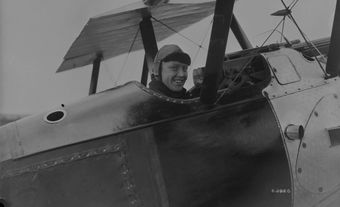John Vincent
John Vincent, career British army officer (b in Ireland 1764; d at London, Eng 21 Jan 1848). John Vincent is best remembered for his efforts to combat the American invasion of the British colonies of Upper and Lower Canada during the WAR OF 1812. Vincent began his career in the British Army as an ensign in the 66th Foot in July 1781, becoming a lieutenant in August 1782. In December 1783 he transferred to the 49th Foot, and was promoted to captain in August 1786. He served in many foreign expeditions, including to the West Indies, where he witnessed the taking of Saint-Domingue, Haiti, in 1793, as well as Holland, in 1799, and Copenhagen, in 1801, during the wars with France. He was promoted to major in 1795 and attained the brevet rank of lieutenant colonel in January 1800.
Vincent in the War of 1812
In 1802, Vincent's regiment was bound for service in Lower Canada, though it soon found itself conducting 9 years of garrison duty in Upper Canada, primarily at York [Toronto] and Fort George. The eruption of the War of 1812 required Vincent to take his troops to bolster the forces at Kingston, which was then under threat. While his combat experience was limited compared to other officers in the Canadas, Vincent was considered a competent commander. His first taste of combat in North America was on the Great Lakes, when the American Commodore Isaac Chauncey forced the retreat of the HMS Royal George to Kingston. Vincent successfully rallied the able-bodied men into the militia to forestall the impending attack, despite having few resources to arm them. Shore batteries kept Chauncey at bay until the winds worked against him.
Vincent's defence of the town was applauded by General Sir George PREVOST, Governor of the Colonies. Vincent was promoted to brigadier general and sent to replace the ailing Major General Sir Roger Hale SHEAFFE to take command of the Niagara Frontier and its 1900 soldiers; among them were dispirited militiamen prone to desertion. Vincent watched the Americans begin building batteries across his main garrison at FORT GEORGE: a prelude to attack. He organized his men into three divisions to watch the frontier: one under Lieutenant-Colonel John Harvey, one under Lieutenant-Colonel Christopher Myers, and the centre division he commanded.
On 24 May, Fort George was attacked by an American bombardment from naval cannon and the batteries across the Niagara River. Three days later 5000 American ground forces landed at Two Mile Creek. As in so many of the battles of the war, the British forces were outgunned and outnumbered. Vincent retreated from Fort George, spiking the guns and destroying the ammunition, and fled with his men west to Burlington Heights [Hamilton]. The Americans took Fort George and sent 3500 infantry and 150 cavalry to chase Vincent and his men down. While considering his next move, Vincent was promoted to major general.
Vincent at the Battle of Stoney Creek
On 28 May, Harvey came to Vincent with fresh intelligence regarding the American advance, at the time resting at STONEY CREEK, and proposed an engagement. Vincent agreed, suggesting a risky night raid to capitalize on the element of surprise. Harvey led the raid, which ended in a major success for the British, and included the capture of the two American brigadier generals and artillery pierces as the chief booty. Vincent, however, was nowhere to be found. Having fallen from his horse while riding alone to the battle, he got lost along the way and only managed to find the encampment after the British victory, an embarrassing end to a successful and daring raid. Vincent pressed the retreating Americans himself, as they fell back to Forty Mile Creek hoping to be reinforced and resupplied. But British victory against US forces on Lake Ontario denied them this support, and the Americans retreated back to Fort George. Vincent's personal efforts, he claimed, bolstered popular support from the locals, who helped capture stragglers and supplies.
A small American detachment of 500 men attacked Vincent's advanced post near BEAVER DAMS on 23 June, but an ambush by Aboriginal warriors forestalled them from delivering a decisive blow against the British. The Americans tendered their surrender to Vincent's subordinate, Lieutenant James Fitzgibbon. The joy of these successes on the Niagara frontier was short-lived, however. British defeat at MORAVIANTOWN on 5 October forced Vincent to abandon his position at Forty Mile Creek for fear of an American advance on Burlington Heights. The attack never came and Vincent was sent to Kingston, the command of the Niagara frontier going to Major General Phineas Riall. In June 1814, Vincent was given command of the Montreal Garrison until his departure for England owing to illness in July. In recognition of his service, he was appointed lieutenant governor of Dumbarton Castle, Scotland.
Neither a talent like BROCK or an incompetent like PROCTOR, Vincent was a long-serving and capable soldier who worked hard against very difficult odds, and took decisive action when the chance arose. He ended the war with a stronger reputation than when it began, which was no mean feat.

 Share on Facebook
Share on Facebook Share on X
Share on X Share by Email
Share by Email Share on Google Classroom
Share on Google Classroom


